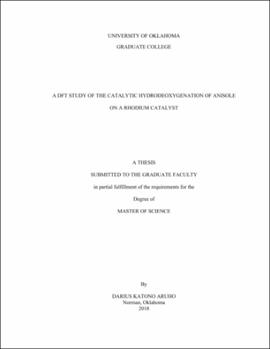| dc.description.abstract | Heterogeneous catalysis is an integral part of chemical industry. Additionally, the surge in biomass research has necessitated a need for newer and effective catalysts to upgrade biomass and its constituents: - lignin, hemicellulose and cellulose. In this investigation, a refining technique of hydrodeoxygenation was investigated. Reactions of a lignin-derivative anisole were studied over monometallic Rh(111) and Rh(533) surfaces. Periodic and first-principle calculations based on density functional theory (DFT) were carried out to study surface adsorption, reaction pathways and barriers and stability of reactants and products. A terraced Rh(111) surface, whose atoms are highly coordinated, and saturated was a good model for large particles that tend to have more extended flat surfaces. Stepped Rh(533), on the other hand, modeled smaller particle catalysts that are more likely to have defects, kinks and edges on their surfaces.
In agreement with comparatives experimental studies in the literature on Pt, Ru, Fe close-packed surfaces, cleavage of Caromatic —O bond on anisole for both Rh(111) and Rh(533) surfaces is not possible with very high energy barriers of 226 and 141 kJ/mol, respectively. The lone pairs on oxygen atom in Caromatic —O are in resonance with the ring, and this π- conjugation makes the bond difficult to cleave. Results on both surfaces also showed that direct demethylation of anisole is not possible either, but instead anisole dehydrogenates successively at the —CH3 group, until the barrier to cleave the —CHx is low enough. The values for demethylation were calculated as 143 and 27 kJ/mol for Rh(111) and Rh(533) surfaces, respectively. Once the —CH3 was cleaved, a phenoxy intermediate remains that waits to either be deoxygenated or hydrogenated leading to varied selectivity. Our investigation showed that Rh(111) facilitates more hydrogenation, while Rh(533) more likely results in the deoxygenation of the surface phenoxy intermediate. It was further shown that oxygen adsorption is a descriptor for deoxygenation catalytic activity. | en_US |
